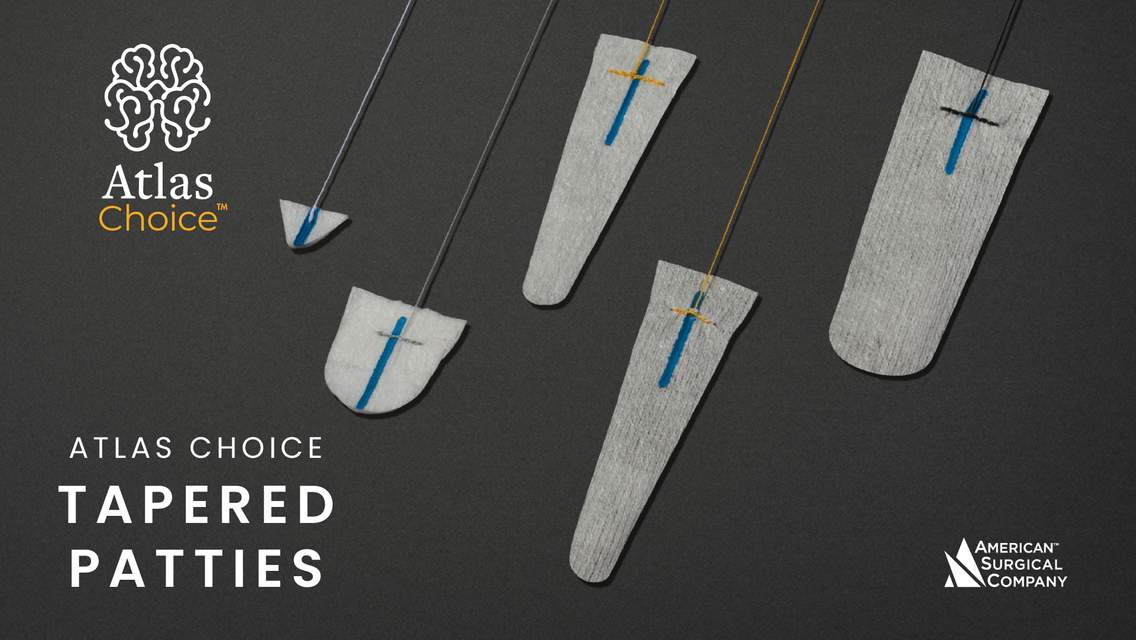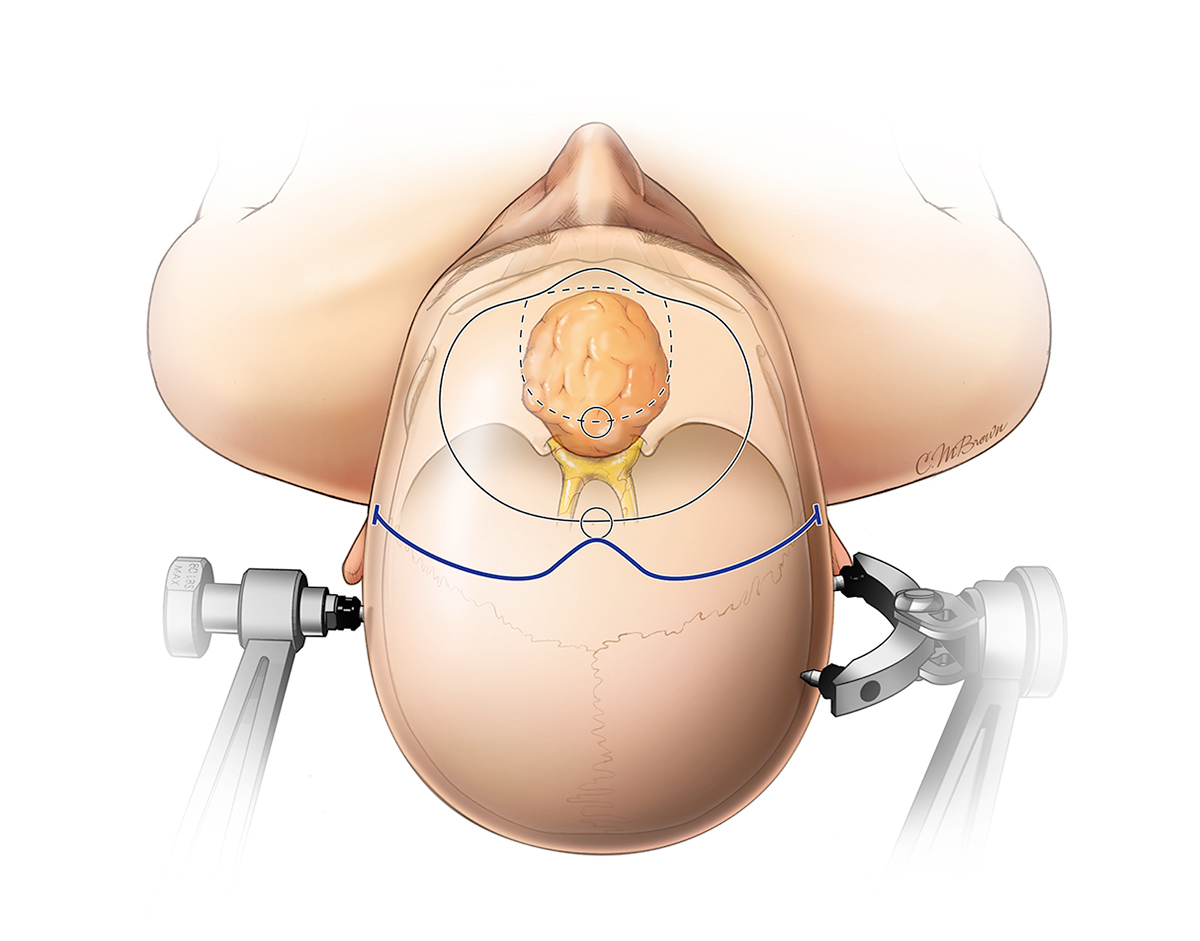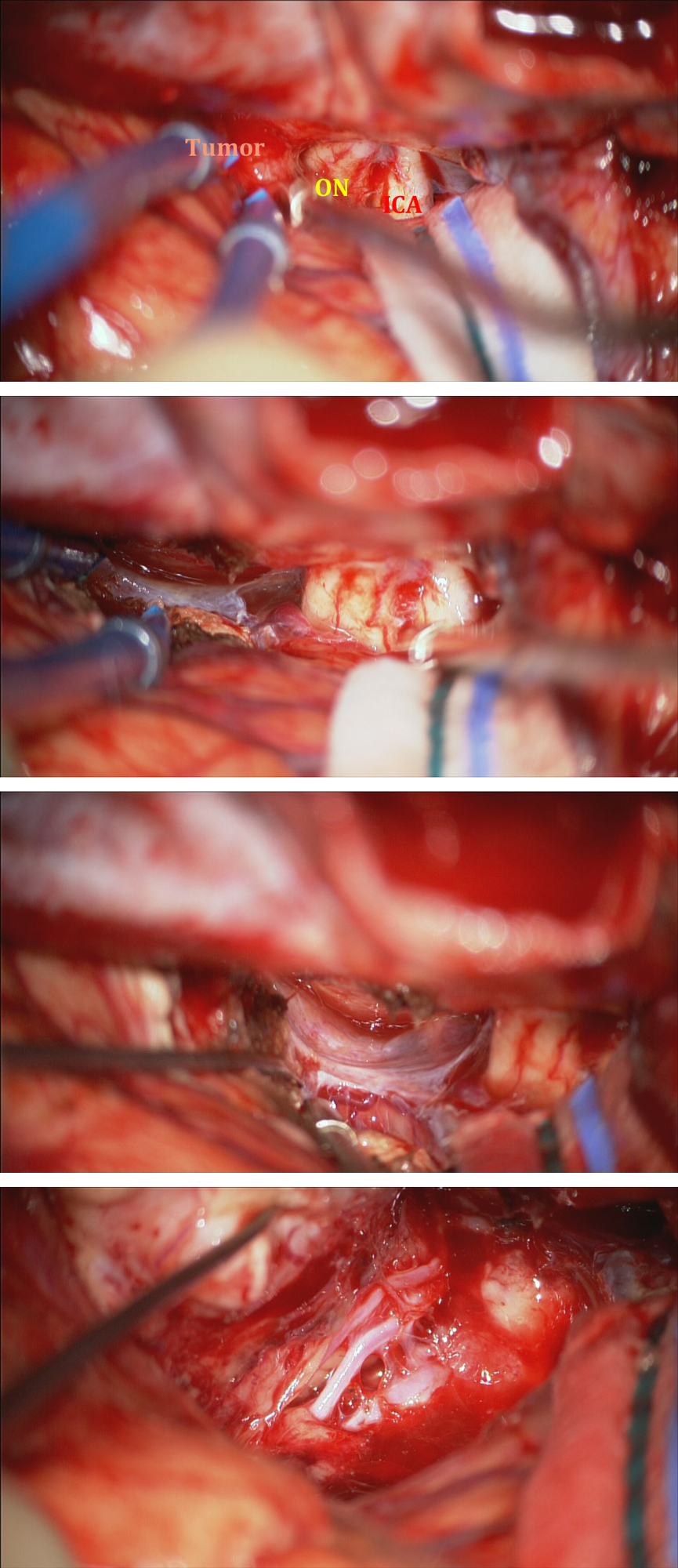Olfactory Groove Meningioma
Figure 1: The cavity left after removal of a giant meningioma from the brain of a patient who died in a “Government Hospital for the Insane” (photo courtesy of the Cushing Brain Tumor Registry at Yale University, circa ~1892).
This is a preview. Check to see if you have access to the full video. Check access
Olfactory Groove Meningioma: Principles of Transcranial Resection
Olfactory groove meningiomas (OGMs) constitute 9–18% of all intracranial meningiomas. These tumors arise in the midline of the anterior cranial fossa at the junction of the cribriform plate and planum sphenoidale.
Tumors arising from this area are in close proximity of tuberculum sellae meningiomas, but these two tumor types behave very differently, primarily with respect to their presentation and mass effect on the optic apparatus. Olfactory groove meningiomas mobilize the chiasm inferiorly and posteriorly, whereas tuberculum sellae meningiomas elevate and symptomatically compress the chiasm.
Olfactory groove meningiomas commonly cause hyperostosis of the anterior cranial fossa floor, and in about 15–20% of cases, erode inferiorly into the ethmoid sinuses. The olfactory nerves are usually displaced laterally by these tumors, whereas the A2 segments of the anterior cerebral arteries are found draped over the tumor capsule superiorly and posteriorly. The orbitofrontal and frontopolar branches are displaced laterally and superiorly, respectively.
Diagnosis
Olfactory groove meningiomas have an insidious clinical course and often grow very large before they are diagnosed. Patients commonly present with headaches, mental status changes including personality changes, short-term memory loss, and lack of motivation. Visual impairment, seizures and anosmia are also likely presenting symptoms.
Visual impairments are varied and include acuity loss, visual field deficits, scotomata, or papilledema. Anosmia is less often a presenting complaint because the patient is usually unaware of this deficit. The triad of anosmia, unilateral optic atrophy, and contralateral papilledema is highly suggestive of an olfactory groove meningioma (Foster-Kennedy syndrome). With the availability of advanced imaging studies, this syndrome is rarely diagnosed today.
Evaluation
After a thorough history and physical examination with particular attention to olfactory, visual, and frontal lobe functions, magnetic resonance imaging (MRI) is performed. The characteristics of the tumor are assessed, including its size, associated cerebral edema, extent of calcification, vascular encasement, and anterior cranial floor hyperostosis.
I also review the tumor’s relationship to the optic apparatus and other parasellar structures. Dedicated imaging of the vasculature is considered helpful to assess displacement or encasement of the anterior cerebral vessels and their branches and potential involvement of the superior sagittal sinus.
I rarely pursue any specific vascular imaging study because the MRI is adequate for providing the necessary information. Embolization of the feeding vessels to these tumors is usually not attempted because of the risk of ophthalmic artery occlusion. Preoperative visual field testing is performed to document visual field deficits. Endocrinological assessment is appropriate for the rare tumors extending into the sella.
Figure 3: A large olfactory groove meningioma (upper and middle images) with associated edema is evident. Note the displacement of the frontopolar and anterior cerebral arteries on the angiogram. This tumor is best suited for a transcranial approach. If the tumor does not extend significantly beyond the middle of the orbit or lateral to the optic nerves on coronal MR images, an endonasal route is reasonable (lower images).
If a large portion of the tumor grows into the nasal sinuses, surgical planning should consider a bifrontal craniotomy or a staged approach to maximize resection of all the tumor compartments. I usually do not pursue an aggressive resection of small intrasinus tumor components.
Figure 4: The details of a bifrontal craniotomy for resection of large tumors with invasion of the nasal sinuses is demonstrated. Note the two different outlines of the craniotomy, the smaller one in hashed lines is more than adequate for giant tumors.
Indications for Surgery
Management strategies for OGMs include surgical resection, stereotactic radiosurgery, and observation with serial MRIs. Indications for treatment include neurologic deficit due to the tumor’s mass effect or edema and documented tumor growth on serial imaging studies.
The best chance for cure of a meningioma is gross total resection with removal of the involved dura and bone. Moreover, the first surgery provides the best chance for achieving a cure. However, it may be necessary to leave small amounts of adherent tumor tissue on vulnerable neurovascular structures in order to maintain preoperative neurologic function. For smaller asymptomatic or minimally symptomatic tumors in high surgical-risk patients, stereotactic radiosurgery can be used as the primary treatment modality.
Preoperative Considerations
I have completely abandoned the use of bifrontal approach for OGMs of any size, and believe that the unilateral pterional or lateral frontal corridor is more than adequate to remove the large or giant OGMs. Many of my colleagues, however, prefer the bifrontal route as it provides more generous exposure of the tumor.
Small and medium-size OGMs may be excised through endoscopic endonasal surgery or an eyebrow supraorbital osteotomy. For these tumors, transcranial surgery offers an opportunity for preservation of olfaction, but the endoscopic route does not. Therefore, if the patient owns intact olfaction before surgery, the transcranial route offers the only opportunity for preservation of the senses of taste and smell. These details must be discussed with the patient before surgery.
Through its lateral operative trajectory, the pterional corridor allows for early identification of the optic nerve and carotid artery, avoidance of the frontal sinuses/bilateral frontal lobe retraction, and preservation of the superior sagittal sinus. An indication for bilateral frontal craniotomy in this tumor type is an attempt to reach the extensive erosion of the tumor into the ethmoid sinuses.
I place a lumbar drain before the incision and drain cerebrospinal fluid (CSF) at the time of the dural opening. Gradual low-volume CSF drainage (10 cc aliquots) provides the frontal lobe relaxation needed to safely reach the opticocarotid cisterns to release additional CSF.
If the cisterns are filled with tumor, lumbar drainage is even more important for brain relaxation to allow mobilization of the tumor and the frontal lobe early to complete the much needed tumor devascularization along the anterior skull base as the first stage of intradural dissection.
The use of prophylactic anticonvulsant medications is highly recommended due to significant cortical manipulation associated with resection of these large tumors.
Operative Anatomy
The anterior and posterior ethmoidal arteries arising from the ophthalmic artery and the sphenoidal branches originating from the middle meningeal artery supply the meningiomas in this region. Pial feeders often parasitize vessels from the anterior cerebral arteries.
Click here to view the interactive module and related content for this image.
Figure 5: Bony anatomy of the anterior and middle cranial base is reviewed. The orange arrows point the typical origin of olfactory groove meningiomas (image courtesy of AL Rhoton, Jr).
Click here to view the interactive module and related content for this image.
Figure 6: Superior view of the olfactory groove and its anatomic relationships to the surrounding structures is illustrated. Note the change in the horizontal level of dissection along the midline skull base compared with the roof of the orbits. This anatomic relationship should be kept in mind during devascularization of the tumor along the skull base. Anterior and posterior ethmoidal arteries are the main source of intraoperative blood loss and their early control at the base of the tumor can improve the safety and efficiency of the operation (images courtesy of AL Rhoton, Jr).
RESECTION OF OLFACTORY GROOVE MENINGIOMAS
Following is a review of the nuances of the technique for resection of large olfactory groove meningiomas through the pterional route. The details of the extended pterional craniotomy are reviewed in the volume dedicated to cranial approaches.
The patient’s head is turned approximately 45 degrees to allow me to work on the contralateral side of the crista galli during the later intradural phase of resection. For giant tumors, the craniotomy is enlarged more medially, but should remain just lateral to the frontal sinuses. A very flat operative trajectory, parallel to the roof of the orbit, is necessary to reach the base of the tumor. An orbitozygomatic osteotomy is usually not necessary.
Figure 7: Tumor location in relation to external and internal landmarks. The head is rotated about 45 degrees. The nondominant hemisphere is the preferred side of approach for this midline tumor.
INTRADURAL PROCEDURE
Early identification of the skull base neurovascular structures is imperative for their protection in the midst of handling of a highly vascular tumor.
Figure 8: This is the initial operative view through a right-sided pterional approach. The anterior limb of the Sylvian fissure is widely split. The arachnoid membranes encasing the opticocarotid cisterns are sharply dissected in order to release cerebrospinal fluid for improved brain relaxation. This lateral operative trajectory allows early identification, localization, and protection of important cerebrovascular structures.
Because of the large size of these tumors and the need for early access to the anterior skull base for tumor devascularization, the use of any measure that can help decrease cranial tension, including preoperative steroids, mannitol, lumbar CSF drainage and propofol (Diprivan), is advised to avoid unwanted frontal lobe retraction injury.
Figure 9: I dissect the arachnoid plane between the ipsilateral optic nerve/chiasm/carotid artery and the posterior capsule of the tumor early in the dissection process and place a small cottonoid patty to cover and protect these structures. Great care is taken to work within the arachnoid planes and avoid aggressive manipulation of the nerve. Such early recognition of cerebrovascular structures allows execution of more efficient maneuvers during which I can remove the tumor without always “looking out” for these vital structures. The anterior trajectory of the bifrontal approach places the tumor between the surgeon and the vital cerebrovascular structures, leaving the surgeon less oriented to the exact whereabouts of the optic nerves and carotid arteries.
All meningiomas are resected using the following algorithm of 3Ds:
- Devascularize the base of the tumor,
- Debulk the tumor, and finally
- Dissect the tumor along the preserved arachnoid planes to protect the adjacent cerebrovascular structures.
The correct order of executing these maneuvers is imperative.
Figure 10: Next, the base of the tumor is thoroughly devascularized as far as possible to expose the contralateral orbital roof. This maneuver is facilitated by gentle mobilization and rotation of the tumor superiorly and laterally, usually feasible because of the previous measures employed to decrease cerebral tension.
This step is critical for advancing the efficiency of tumor resection and minimizing blood loss, especially in the case of a large vascular tumor. The tumor is shaped like a mushroom and the dural attachment at its base is smaller than its dome. Heat injury to the optic nerves and carotid artery is avoided.
The ethmoidal artery feeders (inset image) along the mid anterior skull base can lead to torrential bleeding because of the avulsion of these vessels during tumor mobilization. I pack Gelfoam powder spheres soaked in thrombin into the bleeding sites within the bone after the skull base has been cleared from the tumor; some pressure and patience often achieves hemostasis. I have even used Bovie cautery to stop bleeding there as these vessels retract into the skull base and their control can be difficult.
Figure 11: The tumor is then debulked using an ultrasonic aspirator, microscissors, and pituitary rongeurs, and shrunken with bipolar cauterization. The olfactory nerves are often too involved with large tumors and are sacrificed. With a small to moderate size tumor, preservation of these nerves is possible through microsurgical techniques. It is ideal to save at least one of these nerves.
Figure 12: Cottonoid patties may be used to create dissection planes between the tumor and the pial membranes. I use microsurgical techniques under high magnification to sharply dissect the arachnoid layers and mobilize the tumor capsule away from the fronto-orbital and other anterior cerebral branching arteries. If the tumor cannot be safely dissected a thin sheet of tumor is left behind.
Figure 13: It is imperative to differentiate tumor-feeding vessels from en passage perforating arteries, especially along the posterior aspect of the tumor capsule. This illustration demonstrates that the A1 segment is adherent to the posterior tumor capsule and the artery of Heubner traveling posteriorly. The inset image shows microdissection of an arterial tumor feeder to ensure its identity (tumor feeder versus en passage) before its sacrifice.
Aggressive indiscriminate coagulation must be avoided along the posterior pole as it can be a significant source of morbidity from this surgery. If an inadvertent perforator avulsion injury occurs, a small piece of cotton is used to plug the bleeding point on the parent artery. Gentle pressure/tamponade and patience is all that is needed to achieve hemostasis. This maneuver will minimize further injury to the parent arterial branch by cauterization. Early devascularization of the tumor, as discussed above, minimizes tumor bleeding and allows microsurgery in clear operative fields.
Figure 14: Once dissection is complete, the tumor and the infiltrated dura are removed. The invaded bone is then drilled away. Preoperative CT scans and navigation can help determine the extent of bony resection. If the air sinuses are encountered, large autograft fat globules plug the defect while a piece of pericranium is used to cover the bony defect. I often remove or drill the crista galli to reach and excise the tumor on its contralateral side.
The optic canals are inspected to exclude intracanalicular extension of tumor.
Olfactory Groove Meningioma: Basic Techniques of Removal
Olfactory Groove Meningioma: Resection via an Eye-Brow Incision and Supraorbital Craniotomy
Further Personal Reflections
Figure 15: The anatomy of the base of the tumor is re-emphasized here: Please note the mushroom appearance of the tumor and the anterior ethmoidal arteries. These anatomical relationships will prevent the surgeon from finding the source of bleeding in the tight operative field at the base of the tumor. Bovie electrocautery applied to the base of skull will plug the transosseus feeding arteries whose lumen is often kept open via the bone around them as they defy bipolar coagulation.
Figure 16: The isolated anatomy of the neurovascular structures in the operative position and intimately involved with the tumor is magnified. The proximal A2 branches are at risk during the dissection and can be significantly adherent to the tumor capsule.
Figure 17: The top view of the pathology and involved structures demonstrates the location of the hypothalamic perforators that are consistently pushed posteriorly and not encased by the tumor. In addition, the distal A2's are draped and displaced at the superior tumor pole.
Case Example
To further elaborate upon the above operative nuances, I am including the following case example.
Figure 18: This patient presented with confusion and was found to harbor a large olfactory groove meningioma with associated edema.
Figure 19: The intraoperative findings via a right-sided pterional cranitomy are reviewed. The first photo demonstrates the neurovascular anatomy in relation to the posterior border of the tumor. The lateral subfrontal trajectory allows early identification of the tumor base relative to the optic nerve (ON) and carotid artery (ICA). The tumor is devascularized along its base while protecting the optic nerve and ICA (second row). The base of the tumor is completely disconnected until the contralateral orbital roof and the pial surfaces of contralateral subfrontal region are evident (third row). After the tumor is debulked and removed piecemeal, the anterior cerebral arteries and their associated branching vessels are dissected from the posterior tumor capsule.
Postoperative Considerations
After surgery, patients are typically observed in the intensive care unit overnight. The steroid dosage is tapered off within one week, depending on the extent of cerebral edema and the patient’s neurologic status. Seizure prophylaxis is continued for about three months after surgery; if the patient has experienced a seizure, then antiepileptic medication is continued for six months to a year thereafter.
Pearls and Pitfalls
- Regardless of their size, most OGMs may be resected though the pterional route.
- These tumors typically reach a very large size and can be highly vascular. Early aggressive and thorough tumor devascularization along the skull base significantly facilitates safe and efficient tumor resection.
- Preservation of perforators along the posterior aspect of the tumor capsule is paramount for minimizing postoperative ischemic complications.
- Indiscriminate pulling of tumor fragments along the operative “blind spots” should be avoided as this often leads to vascular and pial injury.
Please login to post a comment.

































